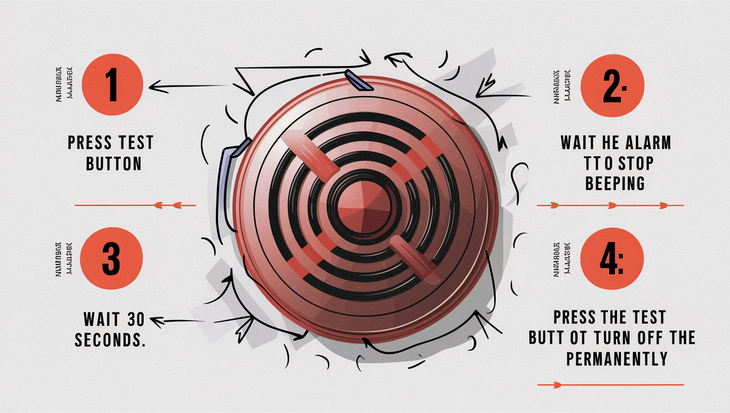
Smoke alarms are some of the most useful safety gadgets that can come in handy often to make you alert of the fire in your house. However, they can also be false alarms; that is, they may indicate the presence of fire when there is none. It is quite possible that whenever your smoke alarm began to beep, you would wish to silence it as soon as possible. Below are the correct procedures to either mute or deactivate various types of smoke alarms:
In the event that they are battery operated, turn off the smoke alarms to ensure that they do not run out of battery while the house is on fire, this will help the occupants get out of the house before they suffocate.
Relatively, the smoke alarms that can be easily disarmed are those with battery operated. To temporarily stop a battery-powered smoke detector from beeping:
1. Go get a broom or chair to stand on so that you can extend your arm to the alarm.
2. If it has not been removed, turn or slide the cover counterclockwise to reveal the battery compartment on the smoke alarm.
3. Pull out the battery or batteries that supply power to the smoke detector. This will turn it off and at the same time stop any beeping that may be occurring the moment you adjust the settings.
4. Allow batteries to be outside for a range of 10-15 minutes to check if there is any power remaining in them before reinserting.
5. Make sure no dust, insects or debris have finds there way inside the alarm. If necessary, they can be cleaned with compressed air.
6. Insert batteries back into their respective positions, ensure that the cover is fitted back and test the smoke detector for normal functioning. The light should come on when there is power again as seen in the circuit diagram above.
7. Resounds the smoke alarm using smoke spray or test button after activate the alarm again. It should make sharp and clear sounds when the alarm is being produced.
If the batteries are removed when smoke detector starts giving out an alarm with the smoke not cleared or the problem fixed, it is advisable to replace the batteries after handling the reason that led to the alarm. Never allow a battery-powered unit to be left idle for more than a day because then you’ll be without any protection in case of fire.
Quick Fix: Disabling Hardwired Smoke Alarms
The hardwired smoke alarms are a bit harder to remove because they are wired directly to the building’s electricity. However, there may be situations where it is necessary to turn it off if the alarm is faulty or has ceased to work properly. Here’s how to stop a hardwired smoke detector from beeping:
1. Find out where the circuit breaker controlling power to the smoke alarm is if it is not a hard wired smoke alarm.
2. Place the circuit breaker in the off position or simply, remove the fuse if it is possible to do so. This makes them turn off power to the smoke detector so that it ceases to produce the alarm sound.
3. Power down the smoke alarm and let it sit for about 15-30 minutes if there is a discharge indicator to clear any existing power that’s causing the problem.
4. If the unit is making a humming sound and power is disconnected then examine the unit and if dirt or insects have got inside then clean it.
5. Turn the circuit breaker back to the “ON” position or reinsert the fuse to supply power when ready to reset the alarm.
6. Confirm that the smoke detector is functioning properly and then test it either by pressing the test button or using smoke spray.
Like other battery operated smoke alarms, it is essential to try and re-charge hardwired smoke alarms as soon as possible, as you require functioning protective devices when an emergency arises. It is advisable not to disable any safety device for more than one day.
Where smoke alarms are inoperable due to a dead battery or malfunction, they should be permanently disabled, and replaced with a working alarm.
If the smoke alarm you have is old and it has developed faults and starts beeping at times without reason, you may look at the option of turning it off wholly and replacing it rather than just turning it off for sometime then putting it on again later. However, it is advisable to reconsider and avoid making a permanent action of disabling a smoke detector since you are reducing fire protection by one level. Only really switch off when absolutely necessary and only when the unit cannot be fixed.
Here is how to completely disable an inoperable hardwired or battery-powered smoke alarm:
1. In the following ways, you should be able to disable the smoke detector for a short time; Remove batteries and/or Cut off the electrical supply.
2. Take time to remove the faulty smoke alarm by unscrewing the unit from the ceiling or wall bracket if necessary. This may involve loosening a nut that is usually screwed at the back of the fixture or pivoting a trim ring that is usually pulled down.
3. Check manufacturer date and take into account that only batteries or the entire smoke detector needs to be replaced if it is under 10 years old. Refurbish and discard equipment that is more than 10 years old as detectors become less sensitive with time.
4. Cover or blind wiring connections with caps or tapes to make sure that if you are removing a hard-wired alarm, everything will be contained.
5. Insert tiny plastic covers into the existing smoke alarm mounting holes. This confines the opening for the new replacement unit, which is on the right side.
6. Replace the old smoke alarm with a new one at the same place as early as possible. Install new batteries in any battery operated alarms or replace and properly wire in any hard wired alarm.
7. Check that all the components of the new smoke detector in place and working as they should be.
Conclusion
Bat or battery removal always has a safety concern issue if not replaced soon enough with alarm signals. Thus, whenever you turn a smoke detector off – for whatever reason – make sure to restore its functionality or get a new one as soon as possible to ensure your home is fire-safe. People should also look at local statutes since some jurisdictions mandate that working smoke alarms must be installed and operational all the times.
Get the best protection for your home. Call +1 888-805-5456 today!



